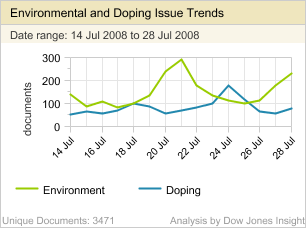By Dow Jones Insight Staff
Beijing’s Olympic Closing Ceremony is over, the  Olympic torch has been extinguished and the countdown to the 2012 Olympic Games in London has begun. But some of the biggest names from the Beijing Games continue to generate media coverage. After eight gold medals and seven world records in eight events, it’s no surprise that U.S. swimmer Michael Phelps continued as the most-mentioned athlete among those being tracked by Dow Jones Insight in social media sources (blogs and boards). Of 7,907 total mentions in social media sources between August 26 and September 8, Phelps had 4,620, or 58% of the top 10 athletes tracked. Much of this coverage concerned Phelps’ appearances after the Games – including his stint as a presenter at the MTV Video Music Awards – and confirms his arrival as a full-fledged celebrity.
Olympic torch has been extinguished and the countdown to the 2012 Olympic Games in London has begun. But some of the biggest names from the Beijing Games continue to generate media coverage. After eight gold medals and seven world records in eight events, it’s no surprise that U.S. swimmer Michael Phelps continued as the most-mentioned athlete among those being tracked by Dow Jones Insight in social media sources (blogs and boards). Of 7,907 total mentions in social media sources between August 26 and September 8, Phelps had 4,620, or 58% of the top 10 athletes tracked. Much of this coverage concerned Phelps’ appearances after the Games – including his stint as a presenter at the MTV Video Music Awards – and confirms his arrival as a full-fledged celebrity.
In a distant second to Phelps in social media sources was triple gold medalist Usain Bolt of Jamaica, who had 1,183 mentions, for 15%. U.S. gymnast Shawn Johnson, who won a silver medal in the women’s all-around competition, followed Bolt with 501 mentions, for 6%. Her teammate Nastia Liukin, who won the all-around gold medal, and beach volleyball gold medalist Misty May-Treanor each had 5% of mentions. U.S. swimmer Dara Torres, who made history when she made the team at the age of 41, had 231 mentions, for 3%. Chinese basketball star Yao Ming, U.S. gymnast Paul Hamm and British cyclist Chris Hoy each had 2% of mentions. Chinese hurdler Liu Xiang, whose withdrawal due to injury led to a national outpouring of disappointment, rounded out the top 10 with 109 mentions, for 1%.

Phelps and Bolt swapped positions in traditional media sources (print and online). Of 11,277 total mentions in traditional media sources, Bolt had 3,863, for 34%. Phelps was a close second with 3,496 mentions, for 31%. Jamaican sprinter Asafa Powell was third, with 829 mentions, for 7%. Hoy had 690 mentions, for 6%. Liukin, May and British swimmer Rebecca Adlington, who won two gold medals, each had 4% of mentions. Torres, Johnson and American sprinter Tyson Gay, who failed to qualify for the finals of the men’s 100 meters, rounded out the top 10 with 3% of mentions each.
Methodology: Analysis includes the English-language sources taken from a database of 6,000 newspapers, wires, magazines, radio and TV transcripts; about 13,000 current-awareness news sites; 60,000 message boards and about two million blogs.
 Although the Beijing Olympic Games had 12 global sponsors, three sponsors led coverage in traditional and social media sources in analyses before, during and, now, after the Games. Those three – Coca-Cola, McDonald’s and Visa – combined to garner 65% of coverage in both traditional and social media during the period of August 26 to September 8.
Although the Beijing Olympic Games had 12 global sponsors, three sponsors led coverage in traditional and social media sources in analyses before, during and, now, after the Games. Those three – Coca-Cola, McDonald’s and Visa – combined to garner 65% of coverage in both traditional and social media during the period of August 26 to September 8.































